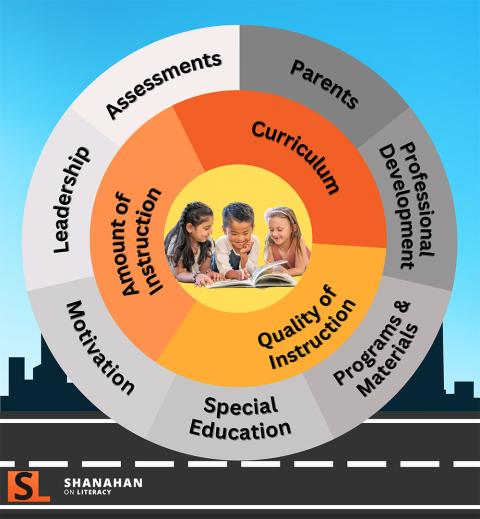Question from a school principal
We are trying to do better in reading achievement — our school is second lowest in our district. I’m convinced structured reading is the way to go and I’m willing to use my budget to pay for our primary teachers to attend the [XX] professional development program. I’ve heard that having teachers take that training is an effective way to improve reading achievement. However, several of my teachers say they don’t want to go, and I can’t require it. I know they respect your opinion, what do you think of that training?
Shanahan’s response
As you can see, I blanked out the name of the professional development provider. I rarely make comments about specific products including this one.
However, research is somewhat mixed when it comes to PD. That doesn’t mean you can’t raise reading achievement that way. We accomplished it in the Chicago Public Schools under my leadership, but this kind of success is not as straightforward as you might imagine.
It may help to remind folks of my school improvement model.
Shanahan model of school improvement

The colorful inner circle includes those actions that usually have the biggest payoffs when it comes to kids’ learning. These are so powerful because they refer to direct changes to aspects of students’ experience. Items in the outer circle matter, too, but only to the extent that they exert an impact on those student-experience variables. As such, outer ring variables tend to have a more conditional and smaller effect than those inner circle variables. PD is in the outer circle.
PD can have a positive impact on children’s learning, but only to the extent that it leads to teacher learning. And, even then, it might not pay off if the teachers don’t implement well what they have learned.
That means there are a lot of “ifs” between the mind of the person/team who created the PD and little Johnny and Janie’s experiences in your second-grade classrooms.
The professional development program must have the right stuff designed into it, communicating practices that really can raise reading achievement. Then, those who deliver the PD must be fully up to speed, sharing what is intended in a powerful way without freelancing. Next, teachers must buy in and really learn what is being delivered and have a desire to implement it. Even then you’re not there yet, because successful implementation may require more than the teachers’ knowledge and commitment — they may need help, opportunities for appropriate feedback, supportive and appropriate curricular materials, and so on.
Of course, the assumption of this kind of training is that if we can just fix one part of the reading curriculum, then everything will be fine. I fell prey to that many times early in my career. I’d provide wonderful professional development focused on how to teach X (Phonics? Vocabulary? Fluency? etc.). I’d convince teachers to include X in their daily instruction, never suspecting that this would end the teaching of Y in those classrooms, which I had naively assumed all children would continue to be taught.
So, indeed, PD can raise children’s reading achievement — if it is the right curriculum, if it is presented properly, if the teachers learn it, if they wish to implement it, if the district provides adequate support for successful implementation, if implementing it doesn’t weaken something else… well, you get the idea. It can work. It also can go wrong in enough ways, that I can’t blithely say, “Send your teachers for PD and your reading achievement will rise.” It just usually doesn’t work that way.
Nevertheless, a meta-analysis of 28 studies conducted between 1975 and 2017 found that “teacher PD has a moderate and significant, positive average effect on reading achievement” (Didion, et al., 2019). The studies varied quite a bit in quality, but at least in some of the more rigorous investigations, PD was an effective tool for raising reading achievement.
This review study didn’t find any mediators or moderators to this effect, though past studies have reported qualitative factors that were correlated with success. Things like making sure that the PD does more than focus on teacher knowledge, putting a strong emphasis on practice. Embedding ongoing PD in the context of the teachers’ work helps too; this can be done through things like collaborative planning opportunities, in-classroom coaching, and the like. Connecting PD to the specific curriculum and materials the teachers will work with is also often reported.
I must admit I have some concerns about the program that you queried me about. It is especially intensive, which is usually a good thing, though in this case I wonder. One analysis of PD efforts that improved learning reported that an average of 49 hours of teacher training was effective — with some programs providing more and some less than that. The program you asked about would be on the upper end of that distribution and it is focused much more narrowly. As much as I believe that we should be supportive of all kinds of learning, I wonder if this would be overkill in many school situations — more attention than would be needed to make teachers successful with the aspects of the reading curriculum you are trying to build up.
Beyond that practical consideration, I also look at the research on it and despite the claims you have heard, the best research has not been especially supportive — it seems to lead to teacher knowledge changes, teacher practice changes (so far, so good), but student reading achievement gains? Not necessarily. In at least one of those successful situations that you related to me, it is important to note that the PD was just one of many elements of school reform adopted simultaneously, making it impossible to attribute success to that program.
I have no doubt that PD programs (including that one) can work. I would be more sanguine about success if you told me you’d reviewed your program and found specific weaknesses in the area to be addressed, that your teachers were eager to take part, that a new instructional program consistent with the training was in the stars, and that you were going for the training too so you could provide the leadership that might be needed to make this successful.
Since your teachers are reacting negatively to the amount of commitment you are asking for, you might want to explore other possibilities. Maybe start with some collaborative learning with the group, getting them involved in reading some of what you have read, evaluating their own practices, and exploring curricular changes that might depend upon successful professional development. Who knows? Perhaps, those efforts will lead them to want to take on the PD you are interested in supporting.
References
Audisio, A., Taylor-Perryman, R., Tasker, T., & Steinberg, M. P. (2023). Does teacher professional development improve student learning? Evidence from Leading Educators’ Fellowship Model. (EdWorkingPaper No. 22-597). Retrieved from Annenberg Institute at Brown University: https://edworkingpapers.com/index.php/ai22-597
Didion, L., Toste, J. R., & Filderman, M. (2019). Teacher professional development and student reading achievement: A meta-analytic review of the effects. Journal of Research on Educational Effectiveness. https://doi.org: 10.1080/19345747.2019.1670884
Garet, M. S., Cronen, S., Eaton, M., Kurki, A., Ludwig, M., Jones, W., Uekawa, K., Falk, A., Bloom, H., Doolittle, F., Zhu, P., & Sztejnberg, L. (2008). The impact of two professional development Interventions on early reading instruction and achievement (NCEE 2008-4030). Washington, DC: National Center for Education Evaluation and Regional Assistance, Institute of Education Sciences, U.S. Department of Education.
Gore, J. M., Miller, A., Fray, L., Harris, J., & Prieto, E. (2021). Improving student achievement through professional development: Results from a randomised controlled trial of Quality Teaching Rounds. Teaching and Teacher Education, 101.
Porche, M. V., Pallante, D. H., & Snow, C. E. (2012). Professional development for reading achievement. Elementary School Journal, 112(4), 649–671. https://doi.org/10.1086/665008
Short, J., & Hirsh, S. (2020). The elements: Transforming teaching through theory curriculum-based professional development. New York: Carnegie Corporation.
Yoon, K. S., Duncan, T., Lee, S. W.-Y., Scarloss, B., & Shapley, K. (2007). Reviewing the evidence on how teacher professional development affects student achievement (Issues & Answers Report, REL 2007–No. 033). Washington, DC: U.S. Department of Education, Institute of Education Sciences, National Center for Education Evaluation and Regional Assistance, Regional Educational Laboratory Southwest. Retrieved from http://ies.ed.gov/ncee/edlabs
About the Author
Literacy expert Timothy Shanahan shares best practices for teaching reading and writing. Dr. Shanahan is an internationally recognized professor of urban education and reading researcher who has extensive experience with children in inner-city schools and children with special needs. All posts are reprinted with permission from Shanahan on Literacy .

